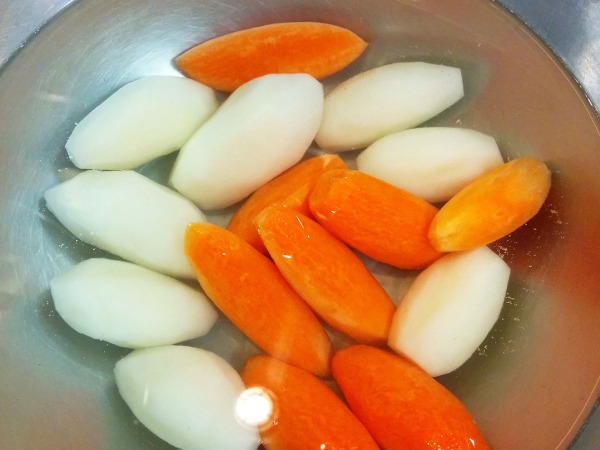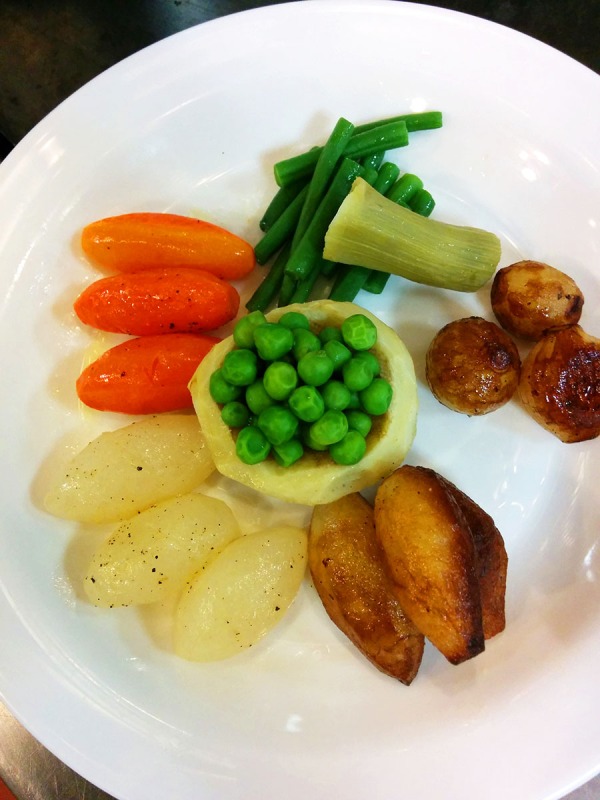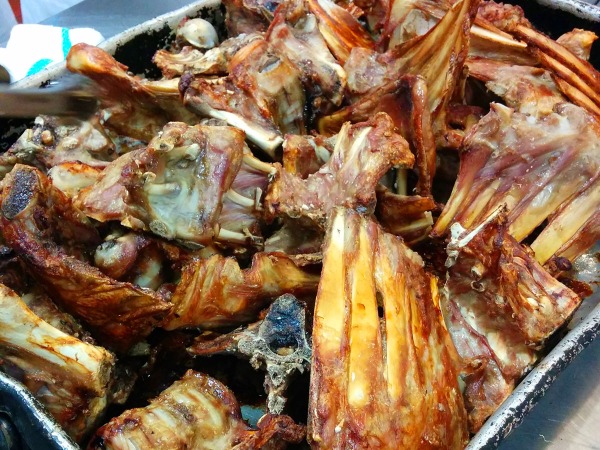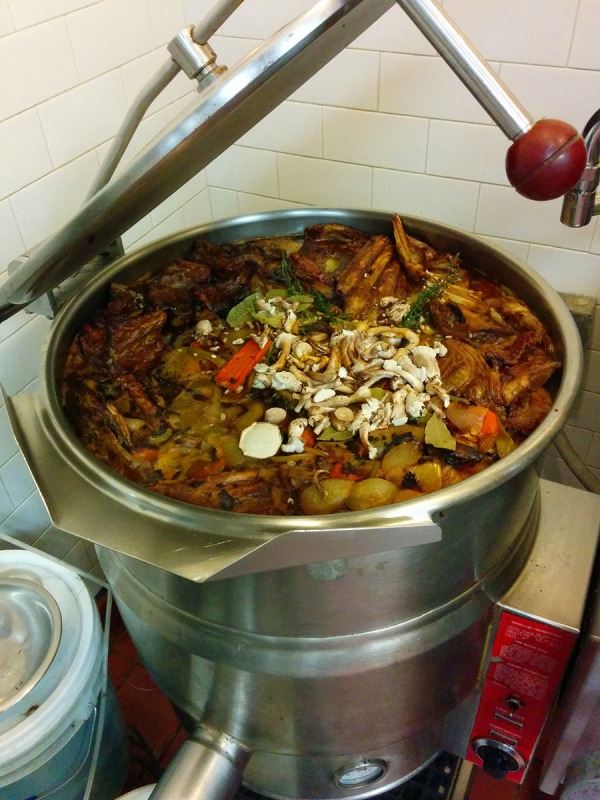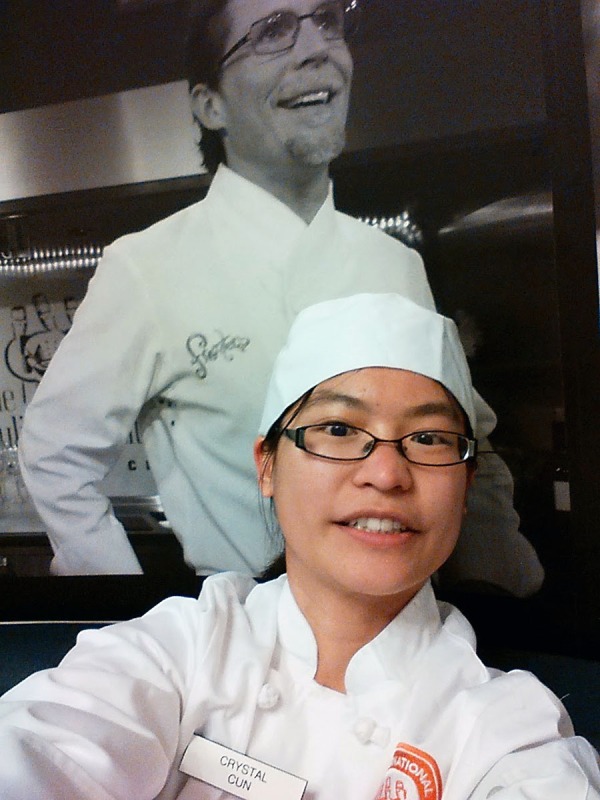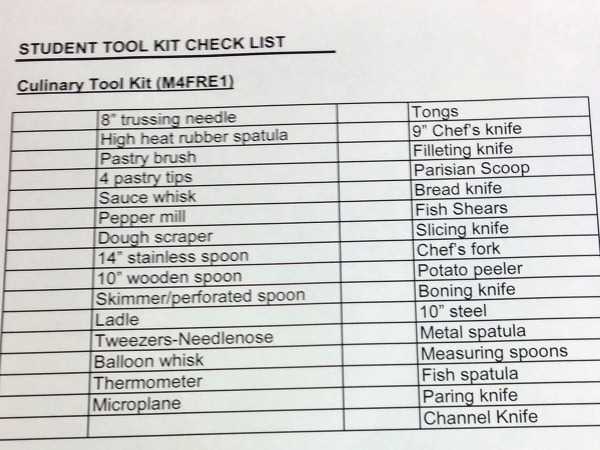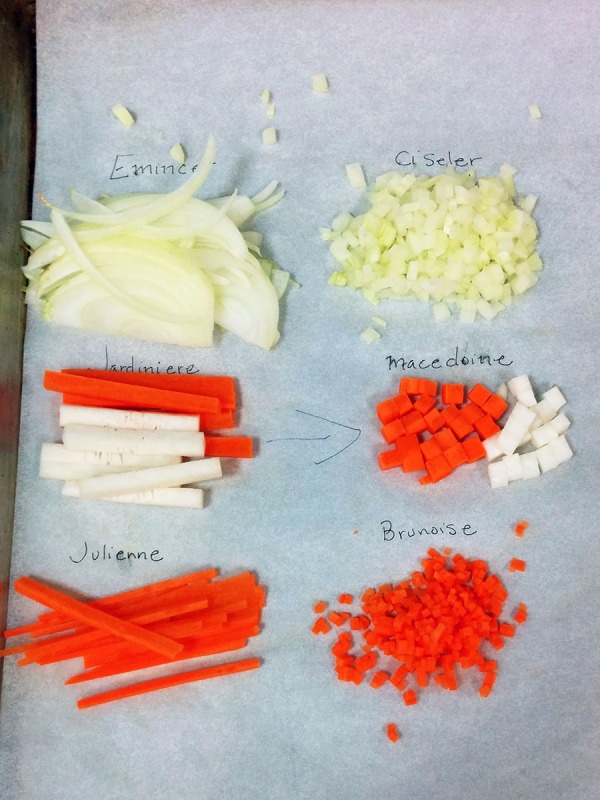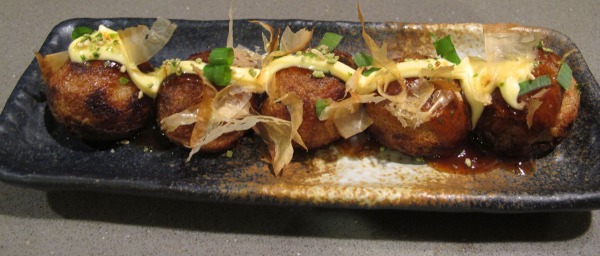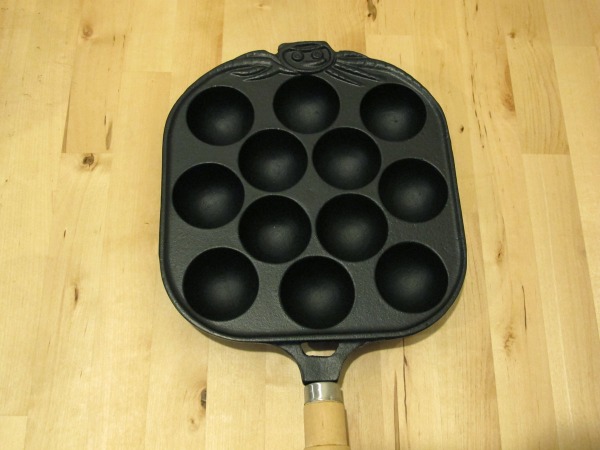After last week’s lesson on taillage vegetable cuts, we reconvened for the quintessential skill of tournage, or turned vegetables. Essentially, you have to cut pieces of vegetables into blunt footballs. “For tonight, don’t worry too much about the number of sides,” said Chef Ray, “but traditionally there are seven sides to each turned vegetable. And remember, you have to use your wrists to curve around the vegetable.” He demonstrated and in just a few deft moves, he held up a perfectly shaped cocotte out of a shower of carrot trimmings.
In concentrated silence, we began turning our own vegetables. My knife zipped through the soft potato, ending precariously close to my thumb on the other end. “Use your wrists,” said Chef Janet, “and when you get home, practice by running a paring knife over an egg. That’s the kind of curved motion and shape you’re looking for.” I cut some diamond-shaped pieces, some flattened pieces, some cylindrical pieces. My fingers began cramping from the unusual knife position. You have to choke up on the paring knife blade and hold it pretty tightly with your index and middle fingers while your wrist guides the motion of the blade. My partner asked my opinion on his cocotte and I replied that it was pretty good, much better than mine.
Between cuts, I was rinsing off my knife to clear the trimmings. Chef Janet stopped by to check on our station and said, “You don’t have to clean off your knife between cuts, just let them fall off naturally. That will save you some time, there’s no need to be anal about it.” I looked at her with some amusement. “Wait, you realize that you’re telling me not to be anal as we cut vegetables into 7-sided footballs?” Chef Janet laughed and said, “Ok good point, be selectively anal about the right things!” On the other side of the station, my partner cracked up and couldn’t stop laughing for a few minutes. I went back to whittling lumpy eggs from my carrot.
Then, it clicked. Rather than starting from one end of the vegetable and cutting through to the other end (as instructed), I could simply start halfway down the vegetable, cut, and then rotate the piece 180 degrees and finish the other side. It would take twice as many cuts, but my results were much more uniform. For the first time, I could visualize exactly where to cut to get the shape that I wanted. Suddenly, I felt like a sculptor, manipulating my knife with confidence and power. At this point, Chef Ray was calling for everyone to clean up, since most of the class was almost done. I was behind and raced to finish my last four pieces of turnip. When I dropped the last pieces on my cutting board for appraisal, Chef Janet examined them and said, “Pretty good!”
By the end of class, we’d cut and cooked all the vegetables for a traditional garniture bouquetière: artichoke hearts, peas, string beans, carrots, potato, turnips, pearl onions. It was a plate of 7-sided vegetables with a total of seven vegetables, a dish that usually accompanies a roast or meat dish. It may look simple but each of these elements is cooked in a particular way, designed to ensure they express their best flavors and look gorgeous to boot. For instance, the potatoes are cooked three times: blanched in salted water, sauteed over high heat, and roasted in an oven with butter. The entire time I kept thinking, is it really worth cooking these same potatoes three different times? But the end product was incredible, a cloud of creamy mashed potato on the inside and crispy edges on the outside. These were the best potatoes I’ve ever made, and it really hints at the gulf between home cooking and fine dining, and the technical prowess required to execute the latter.
The next class was Stock Day. As a class, we made marmite (beef stock) and veal stock, and in teams of two, we each made chicken stock and fish stock (fumet). The overarching goal of stock making is to extract desirable flavors (no masking flavors like garlic) and to remove impurities (remove blood, foam and excess fat). I’ve made “stocks” before, mostly consisting of vegetable scraps and leftover bones from roast chickens, but I’ve never had the breadth and quantity of ingredients to make a truly top-notch stock. “Now remember, you never add salt to a stock, you never cover a stock, and you never stir a stock,” said Chef Ray. “Stock should be clear at the end, not cloudy.”
For veal stock, you begin by roasting bones until they are golden brown. The smell of roasted veal bones soon filled the air, and we all inhaled deeply. Next, you roast your mirepoix (carrots, onions and celery), using the moisture from the vegetables to deglaze sucs from the bone roasting pans. Everything gets combined with cold water, and then all that’s left to do is to skim the foam off the top occasionally while the pot simmers, and wait for 8-12 hours. Luckily, Chef Janet would be present to help strain and cool our stock, so we wouldn’t have to be there in the morning. I gazed at our 80 gallons of veal stock, burbling away in a steam kettle. It was a thing of beauty.
Fish stocks are much more delicate and only require 20 minutes or so of simmer time. Each team was handed 3 sets of flounder bones and tasked with cleaning them. I’ve never cleaned a whole fish before, and I looked at my partner with trepidation. “Uh, did you see how Chef cut out the gills? Because I still have no idea where the gills are,” I said. My partner swooped in to the rescue, “Oh, they’re right here, see these red ridges? I go fishing a lot, so I’m pretty familiar with fish.” I snipped out the gills with kitchen shears, then scraped out the rest of the fish roe, heart, stomach and other entrails. It reminded me of biology dissections, except I have no desire to eat frogs in formaldehyde. Next, we cut up mirepoix (onion, celery, white leek, mushroom; no carrot to retain the purity of the stock color), sweated our vegetables in butter, and added the bones and water.
After we simmered our fumet, we let the stock settle, then used tongs to carefully lift out bone and vegetable solids from the top and slowly ladled out the stock into another container. This avoids agitating the sediment at the bottom of the pot. The final 1″ or so of the liquid in the stockpot was simply tossed. All of the stocks were chilled and frozen; we would be using them as a class for the remainder of the course.
Next week: sauces and legumes.
